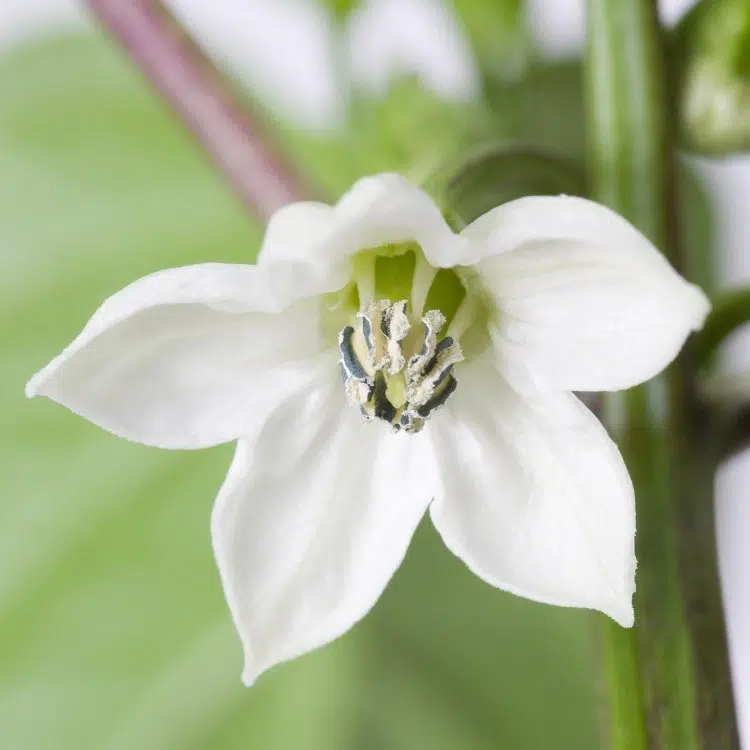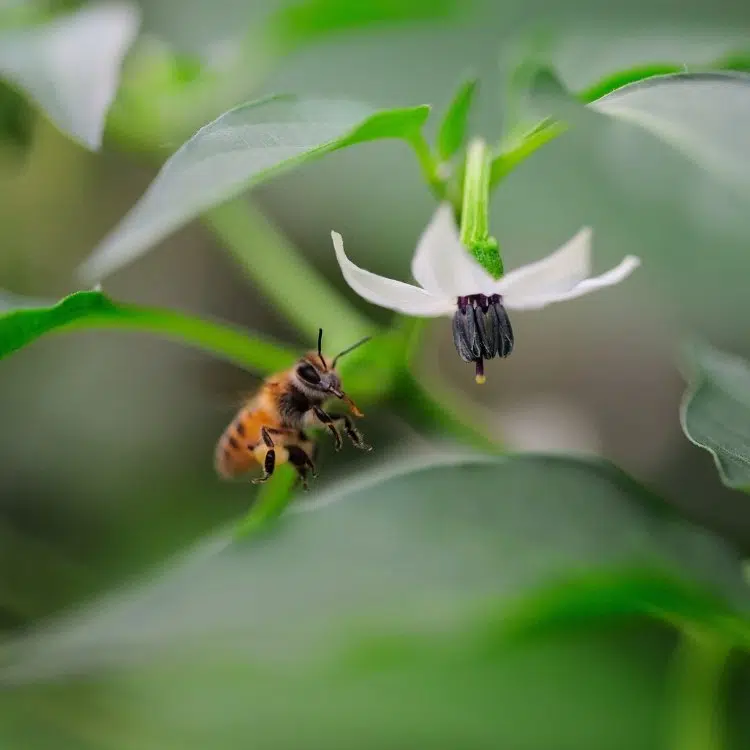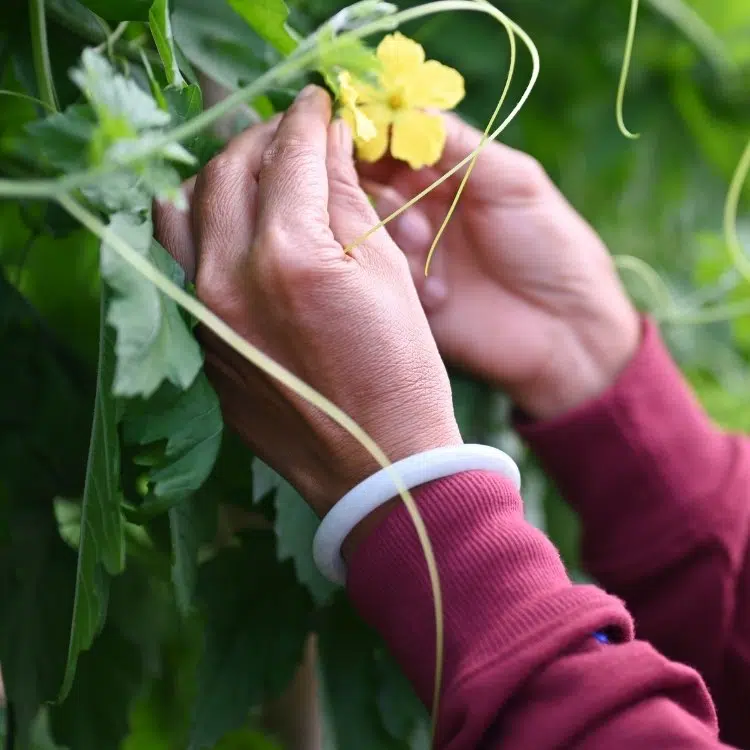Watching pepper plants grow in the garden is one of my favorite things. It’s fascinating to see the plants produce fruit and bear peppers.
But keeping a pepper plant healthy and thriving can be a challenge and the process of pollination for peppers is something you have to keep in mind.
Are Peppers Self-Pollinating?
In short, yes, pepper plants are considered to be self-pollinating. Pepper varieties from sweet peppers to hot pepper like jalapeño or habanero peppers, are self-pollinating.
What is Self-Pollination?
Just because peppers are self-pollinating, that doesn’t mean that they just magically pollinate themselves. A little intervention still needs to happen.
Pollination is a little like humans making babies. It’s a fertilization process that flowers need to stimulate the development of fruit.
Self-pollination means that a pepper flower doesn’t need pollen from another plant or even another flower to be fertilized. Pollen from the same flower is enough to start fertilization.
Self-pollinating plants just need a little “stimulation” to move things around and get the process started. Typically this happens from a pollinator like a bee or butterfly, but strong enough wind can help as well.
However, there are a lot of factors that come into play that might impact how effective natural pollination is. If you’re growing indoors or nature can’t do it, then it might be up to you to help pollinate your pepper plants.

Methods of Pollination for Peppers
As I alluded to above, there are a few ways that your pepper plants might pollinate.
Pollination by Pollinators
The birds and the bees, the way nature intended! Pollinators are great at helping to pollinate pepper flowers. While it’s not their “main job” it’s a very important one at that.
Without pollinators, we wouldn’t have many peppers or much food for that matter! Pollinators are a gardener’s best friend. They can help your plants produce a bigger yield and even assist with the development of fruits that might not have been possible otherwise.
They are our best chance at keeping a garden that doesn’t require even more work from us gardeners. If they weren’t around, we’d have to manually pollinate every plant we grew.
How to Attract Pollinators to Your Plants
Generally, bees, moths, butterflies, and more will find their way to your garden, but there are lots of ways you can attract pollinators to your garden, even if you have a small patio or balcony.
Plant a Bee-Friendly Flower Garden
Planting peppers alongside a variety of flowers means you’ll have a beautiful view to add to your environment. If you plant bee-friendly flowers that produce a lot of pollen, they’ll come for the flowers and stay to pollinate your peppers.
Flowers with small petals are best because larger petals can deter bees from flying through them. Lavender, bee balm, Black Eyed Susan, and borage are great additions to any garden and will help bring the bees!
You can also plant some extra mint or chives a little earlier in the season and let them go to seed (i.e. grow flowers) for the pollinators to enjoy, and pollinate your peppers and other plants.

Keep Water Around
Pollinators need water while they’re out doing the hard work of pollinating our pepper flowers. A nearby birdbath will do just fine.
Companion Planting
Companion planting is growing plants that help each other near one another. For example, herbs like cilantro and dill are great companions for a pepper plant because they attract parasitic wasps that feed on aphids (which are a big problem for pepper plants). And, if you let cilantro go to seed, it produces beautiful flowers that attract even more pollinators.
Avoid Using Pesticides
This should go without saying since you’re going to be eating your crops, but while pesticides might help control weeds, they can also kill bees and other beneficial insects.
Hand Pollination
Hand pollination might make you look a little crazy to your neighbors, but your garden will thank you! You can hand pollinate pepper plants to work around the issue of self-incompatibility (cough, cough) by using a small paint brush or a cotton swab to transfer pollen from one flower to another on the same plant.
You’re essentially simulating a bee, and moving from flower to flower “shaking things up” and pollinating so your plants produce fruits.

You can use a variety of things to help pollinate your plants flowers:
- Cotton swabs
- Toothpicks
- Toothbrush
- Vegibee sonic pollinator
This technique is commonly used in greenhouses and by pepper enthusiasts who grow hot peppers. If you’re looking for a way to ensure your plants produce the fruit you want, consider hand pollinating early in the morning when it’s cool and before any rain falls.
Cross-Pollination
Cross-pollination is when pollen is transferred from one flower to another on different varieties of plants. If you have a chili pepper near a bell pepper plant, a pollinator could create a hybrid if they were to visit both varieties on the same day. You would end up with a cross-pollinated hybrid pepper, which would not reproduce as exactly as the original two varieties.
While the outcome might be delicious, if you’re saving seeds or planning on selling them as one breed, you’ll need to keep these two separate or use mesh bags to avoid exposure.
What to Do if Pollination Doesn’t Work?
While pepper plants are considered self-fertile, that doesn’t mean they will produce a full harvest on their own. In fact, some varieties of pepper plants might not produce fruit at all unless they have been pollinated by another plant.
In order to ensure optimal results from your pepper cultivation efforts, consider hand pollination or growing more than one variety close together, but separate. If you want chili peppers but don’t want anything to cross-pollinate, grow red chili peppers next to your jalapeno pepper plants so nothing else can get in there.
You can also pollinate them yourself and put mesh bags on the flowers afterward to ensure a bee doesn’t come by and cross-pollinate. Just allow enough space for the flowers to open and spread pollen naturally.
Most of the time, this isn’t an issue for most plants, but sometimes plants can become self-incompatible due to how they were bred.
Do Pepper Plants Need to be Planted in Pairs?
Pepper plants do not need to be planted in pairs. They are self-pollinating and don’t require it for the pollination process. However, if you’re not growing much else in your garden, it is ideal to plant more than one. The more flowers in a garden, the more likely pollinators will come and hang out. If there is only one, the trek might not be worth it for them.
How to Tell if a Flower is Pollinated
This can be a tricky thing to tell. Once a flower has been pollinated, according to the Garfield Park Conservatory “the ovary of the flower will become fleshy and meaty – this is what we know as fruit!”. The plants do this in order to protect the seeds.
Flowers will also wilt once they are pollinated, so this is another thing to look for. While you might be thinking that your flowers are dying or ready to fall off, it could be a sign that they were pollinated.
Why is My Pepper Plant Not Producing Fruit?
If your pepper plant isn’t setting fruit, or only growing a few peppers, it could be due to a variety of factors impacting the successful pollination process.
There are a few reasons why “natural” pollination might not be happening.
1. Pesticides
Pesticides can impact the presence of pollinators and how well they can stimulate pollen release.
2. Stagnant Air / Lack of Wind
Wind is a crucial part of the pollination process. If indoor gardening and growing pepper plants inside, make sure you have fans blowing to simulate wind and keep your pepper crops producing fruit.
3. Weather Conditions Affecting Pollination
Pepper plants take approximately 70 days to fully mature and produce fruit . This is quite a long time for weather to play a big role in affecting pollination for peppers. Whether it be rain, wind, or too much sunlight, weather conditions can play a big role.
If rain or wind is harming the pollen in any way, it could prevent fertilization from occurring naturally. Remember that humidity and dryness can also impact how well this process works for peppers during the growing season. If pollen is too moist from humidity, it won’t be able to move around as freely, making the process of pollination more difficult.
If the weather gets too hot (over 90 degrees Fahrenheit), it can also impact photosynthesis, and cause your plant to stop growing properly. You can use a shade cloth to help prevent the scalding sun from wreaking havoc on your pepper plants.
Whether you’re growing sweet bell peppers, chili peppers, or ornamental peppers, pollination is critical for female flowers to set fruit. One pepper plant is enough for pollination, make sure you have other plants around to attract pollinators, or you might be out there with a toothbrush in early spring doing it yourself. 🙂



Might a Vegi Bee device work?